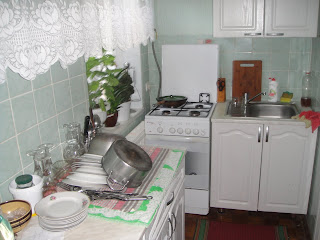It is interesting the differences between Moldavians' and Americans' view of food and the kitchen. It is very common for houses to have two kitchens (especially the middle class and higher), a kitchen for summer and one for winter. The winter kitchen is in the house while the summer kitchen is usually in another building. They do this so that they can cook the food without making the house any warmer in the summer. I think that this was also common in American 50 years ago, or maybe it was just my grandparents who had them.
Most Moldavians can/preserve vegetables and fruits that they grow during the summer. The majority of houses have a basement where they keep canned goods. Because the basements are built into the ground it stays cool during the summer so it is possible to keep fresh products too.
It is not uncommon to keep fresh milk, eggs, and cheese in the basement instead of the refrigerator. A lot of homes have refrigerators, I do not know the percentage, but the middle and upper classes defiantly have refrigerators. The refrigerators are generally smaller than in the USA. But even if they have refrigerators it is not used the same as we do in the USA. It is not uncommon for leftovers to be left on the stove overnight if they will be eaten the next day, if it will be more than a day the leftovers will be put into the refrigerators. In my experiences with two host families, they do not seal up the food when put into the refrigerator. In the USA I feel like everything except for fruit must be in Tupperware or wrapped with saran wrap.
It is common to have a microwave but not to have a toaster. Mixers, food processors, blenders and such are available and not uncommon but many people do that type of things with their hands. It is becoming more common to have washing machines (it seems like always the front-loaders, I have not seen a top loader here) but I have not seen a dryer. Dryers are available, but generally hotels and hospitals and such have them. Even during the winter clothes and hung to dry (outside and inside).
I find these differences interesting; they are even cooler when you know why (belief, economy, tradition, etc) things are done a certain way.








0 comments:
Post a Comment